#blach and white with color
Explore tagged Tumblr posts
Text
So one time during a lifetime of dying my hair different shades so I wouldn't have an acute psychiatric episode, I used one of these episodes to bleach my hair for a future light colored dye job. I also decided to blach my eyebrows so I could have colorful eyebrows. I have impulsivity problems and decided on the eyebrows in the bathroom while my hair was already setting and didn't talk it through with my mom first.
Some of you will see where this is going.
When I washed off all the bleach and came out of the bathroom to show off my wonderfully prepped hair [it was nearly white gold! I could dye literally anything over this and it would work great! I was already excitedly scheduling my next emotional crisis for a 12 days out so I could try out cotton candy stripes!]
My mother looks me up and down and says one word. "No."
I'm very confused.
She darts out of the room and returns with a handheld mirror and mascara. She shoves both at me and says "you look like a nazi" and walks away.
I look in the mirror. Oh no. I *do* look like a nazi. I rip the cap of the mascara and start adding color to my eyebrows and hair as quickly as I can and I hear my mother's car start up. 15 minutes later she's back with a 1lb jar of coconut oil and a gallon jug of avocado oil and a box of baby blue hair dye, and we spent the next 24 hours triaging my hair post-bleach so we could dye it the next morning before school without destroying my hair entirely.
So like. Yeah. My primary associations for "a little too blonde" are "those weird swimming pool guys in california who are obsessed with looking like surfers but won't go near the ocean" and "nazis" and I wouldn't want either of them near my dick.

26K notes
·
View notes
Text

In direzione ostinata




e contraria.
#streetphotography#fotografia#photography#sardegna#canon camera#sardinia#poetry#photo#blach and white#biancoenero#bosa#Oristano#blanco y negro#canon color
4 notes
·
View notes
Text



elina
2 notes
·
View notes
Text
Blach and White is what I think Knives and Vash's personalities would be w/o the Tesla incident.
White: Look like a happy go lucky girl but actually the more emotionally mature one. With slit dress!
Black: Kind of nerdy. Normally a sweet boy but can become scary when his sister is involved.
Fun fact: According to the July issue of Newtype, the director of the Kekkai Sensen wanted to put a twins which has a twin-tailed girl so bad that he asked Nightow to redrawn the design for anime only characters several times until he got what he wanted. He said he was influenced by the previous work, Trigun.


I can't find trimax Knives in color for the life of me... but he has blue eyes like Black.
#kekkai sensen#wait... when I think about the ending then....#did the ks director want Vash to....#lol#trigun maximum#trigun#trigun manga#trigun stampede
59 notes
·
View notes
Note
Saw your post! umm can u draw my oc cayden? :0

There new design :DD (i hate the old one fuck)
colours (cuz fuck I didnt color this yet)
hair: Blach and a shade of white
skin: Peach :D
The coat? (wtf is that?): Light purple and lavender purple
the vest? thing: Dark purple
and thats all :DD
yeah

Oh yeah, congrats on 64 followers dude!
#Art#Request#OC Drawing#Artist#Digital#DigitalArt#digitaillustration#artistsontumblr#artists on tumblr#coolbfbx#i hope you like it!#this took less time to make than expected- lol.
10 notes
·
View notes
Text
What it Means to Be a Woman
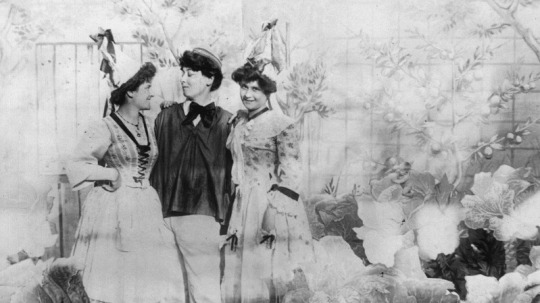
Alice Guy-Blache, who is considered the first female director in the world, is one of the pioneers for women in the film industry to create and direct films that were conceptual, but unique at the time. One of her films that we watched in class was titled, Midwife to the Upper Class, which was released in 1902. It was almost like a sequel or extended version of her other short film, The Cabbage Fairy (1896). Midwife to the Upper Class was a silent, black and white short film that depicted a fairytale-like universe where a woman seems to be selling baby dolls. A couple discusses what they want to do and they end up looking through all the different babies in a garden that is filled with cabbages. The couple decides which baby they want while the woman selling the babies picks up each one to show them, but puts them back down when the couple shakes their heads. The woman also shows a colored baby doll with black skin, which I thought was interesting, but the couple disregarded the doll until they found a real baby to adopt.
I thought this film was very unique because of the set design and the plot at the time. Guy had a woman working behind the stand, showing how independent she was (which was not common), while also showing another woman, the wife, how she had the choice to pick her own child. The man wasn’t deciding for her, he was only helping pay for his wife, which is another issue that was depicted, of how women have to get their finances from the man in the family.
This ties into one of the readings that we were assigned to read for class, “What It Means to Be a Woman: Theorizing Feminist Film History Beyond the Essentialism/Constructionism Divide,” Not So Silent: Women in Cinema Before Sound (2010), by Monica Dall’Asta. She talks about how women in films were usually absent because of the “inabilities” and that the stereotypes made it harder for women to be respected. Because of this division between genders, it has made it difficult, not just for female actors, but especially for female directors to receive any recognition for their work, which is why Guy is an important/influential woman to be changing those stereotypes with her work, by bringing awareness to these gender issues.
0 notes
Photo
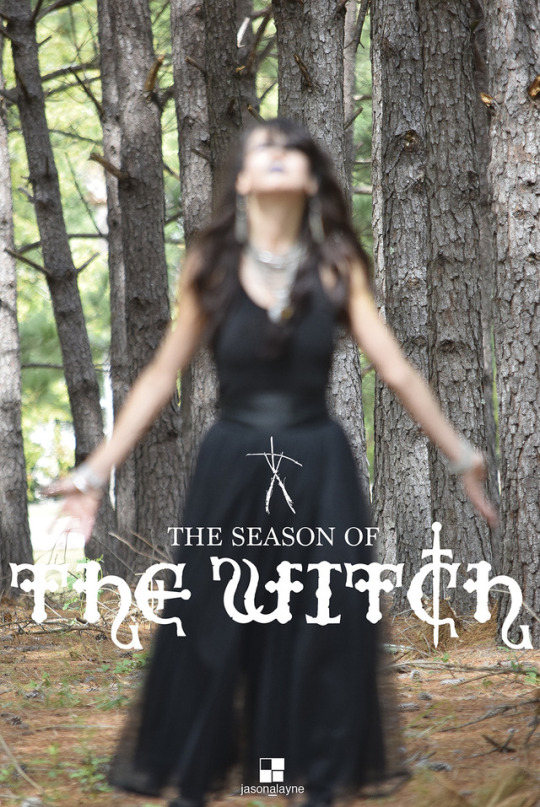
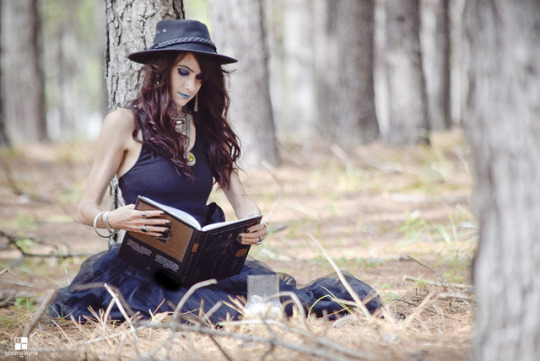
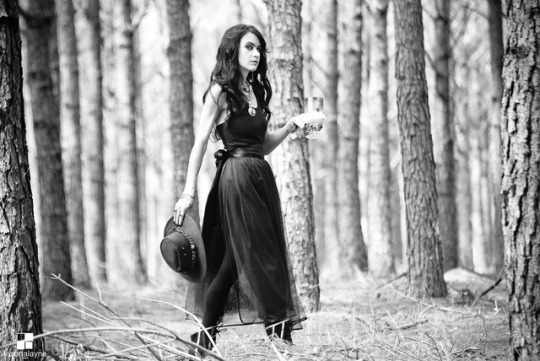
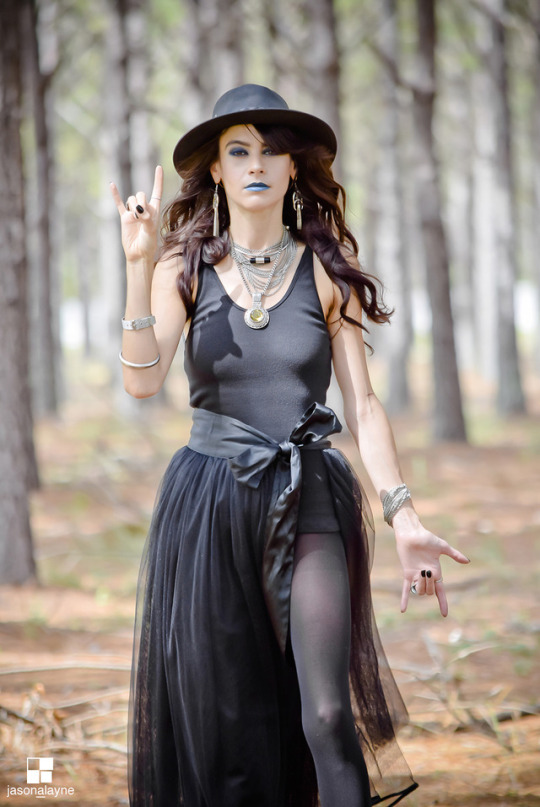
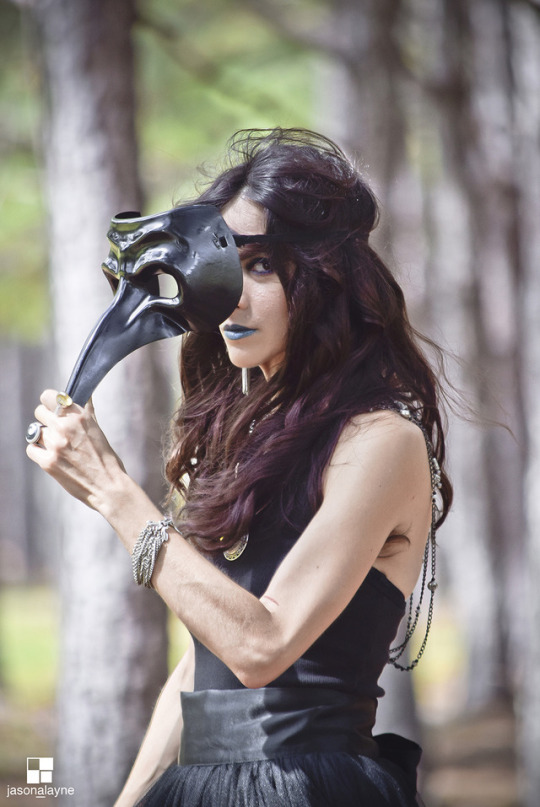
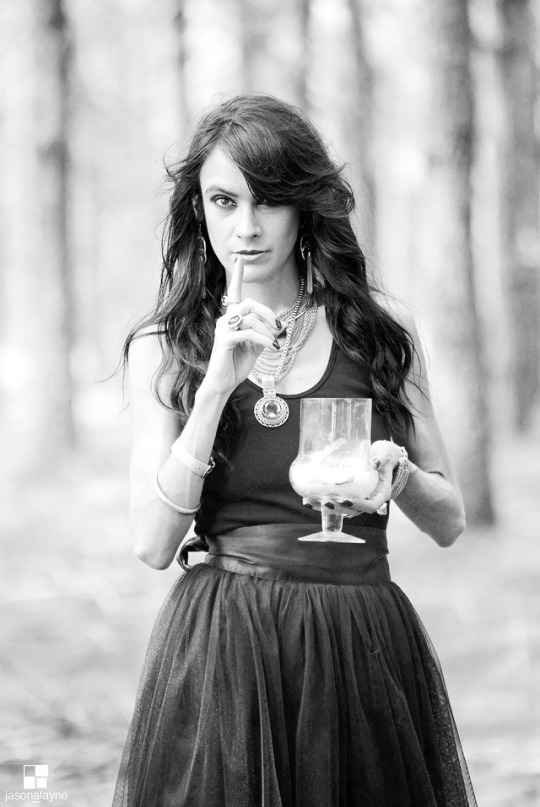
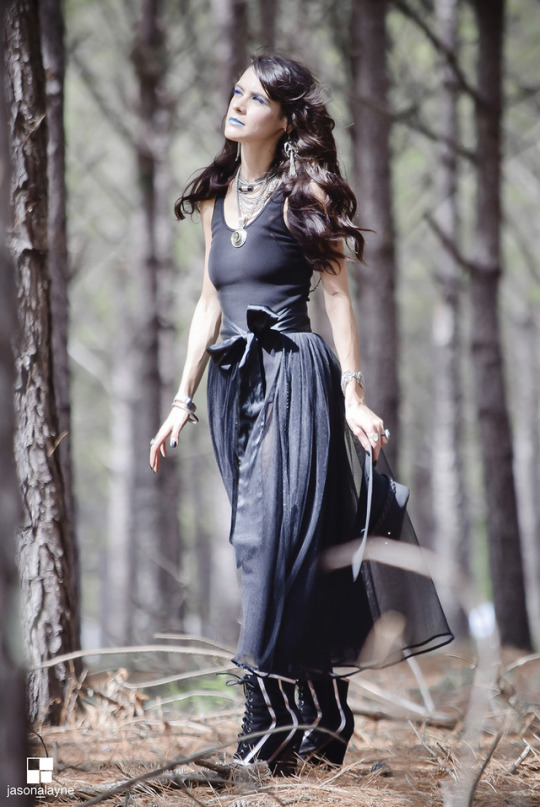
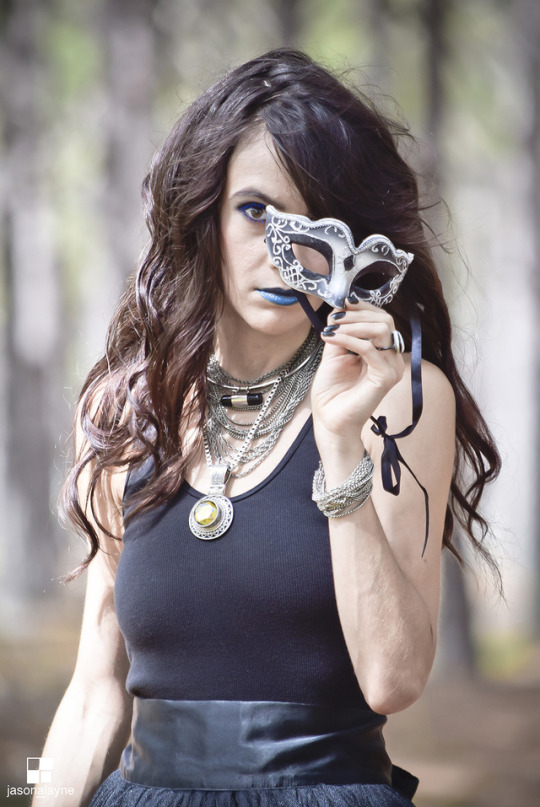
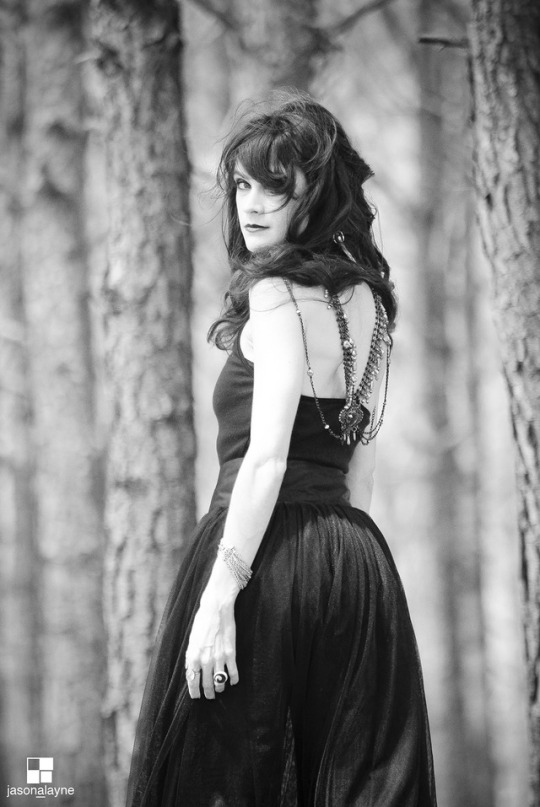
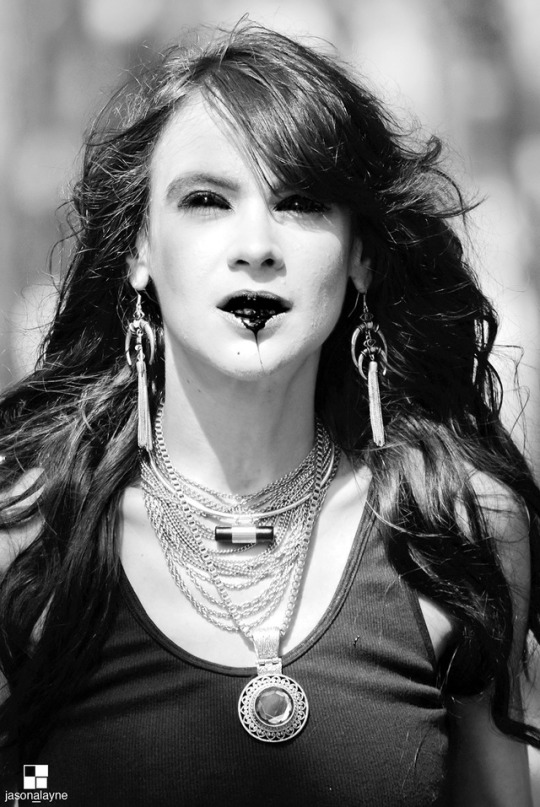
“the season of the witch.”
“i wanted nothing but silence, black woods, decay, cold winds; to lie twisted and turned like a serpent, to be in unison with a dying earth.”
"death season” by segovia amil
it’s been a while since my best friend erika and i did a photoshoot. the last one we did was a almost exactly a year ago; way too long for artistic minds to be apart. i’ve been thinking of a “witch” idea for quite some time. the initial idea was to picture a witch drowning, referencing the salem witch trials and the nirvana song, “serve the servants” in which kurt sings: “if she floats than she is not, a witch like we had thought.” that idea was scrapped though, since we couldn't find the right time, props, location, etc. so, we settled for our favorite woods location.
as always, erika did a great job on her wardrobe. black dress, hanging jewelry, black nails...the make-up was great too: pale skin contrast against black and blue lipstick and eye shadow, wavy hair with blueish and purple highlights. we had a few props we brought along too, to make it more spooky, just to add to the effect as well as blacking her eyes out and adding fake blood coming from her mouth. this is certainly something i would not like to see walking through the woods at night. or during the day for that matter. it gives me goose bumps just looking them.
on the other hand, we have the poem. the poem is something i found online while looking for old witch related documents and stories about the witch trials and possession. not sure why “death season” was tagged while searching for these things, but i read over some of segovia amil’s other poems and she now has a new fan. they are short, to the point, beautiful and dark. perfect as a sidenote to this photoshoot we did. overall happy with the outcome of this pojsect and hopefully it won’t be too long before we get together for another one.
enjoy...and sweet nightmares.
#photography#digital#blach and white#b&w#color#witch#woods#the season of the witch#photoshoot#segovia amil#poem
0 notes
Text
Black
The word black comes from Old English blæc ("black, dark", also, "ink"), from Proto-Germanic *blakkaz ("burned"), from Proto-Indo-European *bhleg- ("to burn, gleam, shine, flash"), from base *bhel- ("to shine"), related to Old Saxon blak ("ink"), Old High German blach ("black"), Old Norse blakkr ("dark"), Dutch blaken ...
of the very darkest color owing to the absence of or complete absorption of light; the opposite of white of any human group having dark-colored skin, especially of African or Australian Aboriginal ancestry.
Black b lack bl ack bla ck
Writing the word black
The colour black comes up i used to like to wear it when growing up to stand out i thought i looked good in black but then i think i put weight on and didn’t wanted stand out and having like to wear the colour black for many many years until recently ive tried to bring it in and wear some now and then and it feels ok grounding sort off.
Reading he word black
I think of how the world and racism has consumed us as people who did this happen and the consequences of this it has had how now black people have starting point that white people think there better than them and they been put down for 100s of years and how this must of affected them no equally at all with this underlying within them, and fears come up within me how is this ever going to be sorted out how can we ever be trusted again for doing this to our own kind i feel this is something that will take a long time to sort out.
I see a picture of a black person some up within me and that i do have fear of them knowing what white peoples like myself have done to them i fear being with one because they might hate me as it were and i fear them doing something to me comes up
Wanting to looked black with a suntan like the darker the better
I remember once in Australia when working a aboriginal girl who was very angry and hated white people for what had happened one night started shouting out this quote how we call them coloured when we are pink out in the sun we are red and so on but ti see her anger scared me to fear black people and i see that I think all black people must think this way.
When you get messages letters from mostly Nigerian people in pursuit of getting money out of you i feel angry on them sending me them and i feel angry at the amount of people they have scammed out of there life savings i a hate towards these people but at the end of the day the people who send all there money are just looking for more money mostly but not all.
I ask myself am i a racist? You know when bad things happen i feel one but i know it all stems from whats been done to African people so how can i blame them i cant but i do have a fear of them that they hate me enough for being white that they might do something.
I met a Rastafarian once we had a short fling but i felt scared what my family would say as my mum was a racist and what others might say so i stopped it.
When i went to gambits at 19 i loved it they were such friendly people we made friends i did think they had a strong smell about them like BO but they said we smelt funny to like pork lol
When you see allo the shout with black people in America i feel sad that have to live in these conditions even in a country that isnt third world but i thing the problem stems down to hundreds of years of racism
Saying out loud black
Fear came up they hate me because ive white
I want to bring black items into the house to ground it i like the look it gives
All my husband mostly wears id black i wish he’d try something else.
How im glad i wasn’t born black because i dont think i could of lived with nor being liked thinking less than a white person i already feel less than not being able to read properly imagine what it would be like to to have this prejudice as well.
Black and white yes or no
Black as the ace of spades this is what my mum would say when wed come home dirty as kids.
Sf
Does this definition support me no so many variable hey a polarity of liking to wear black but not be a black person because thought of I couldn’t handle it.
Black be act
Black
The colour black
How will your live this word> i will live this word as the colour black and thats it if a person of colour is proud to be black than thats great for them i think person of colour is better to drop this word of racism that must hurt so many of our fellow man and divide us no more to come together as one once and for all to stop this.
0 notes
Photo

The film “Edited By”, by Su Friedrich, is a companion film to the website WomenFilmEditors.princeton.edu, and it holds a one minute scene from a film edited by each of the sixty-five editors who were represented on Friedrich’s website, from 1924 to 2017. The website is a comprehensive guide to many of the talented women editors that history chose to forget (and now actually includes 206 editors), and includes things such as the editor’s backstories, history, surveys, film posters, and more. The film is organized chronologically, and Friedrich herself has stated that this film is not meant to “be a “real film”- that is a film I would consider part of my body of work- but rather a sort of notebook or reference film”. The overarching theme of this film is representation, and the clearly emphasized issue is that of the under-representation of editors (although both men and women, this film focuses on women editors), and it seeks to give the audience a flavor of the type and range of editing for a shockingly vast number of works created by women editors, spanning time from 1924 to 2017.
.
It is challenging to qualify the form of the cinematography of film in this movie, as we have works ranging from more languorous and elegant editing, such as found in “Louisiana Story” or “Moonlight”, all the way to the fast-paced and intense editing style we see in “Persona” or “Mad Max: Fury Road” represented in this 75 minute film. Each one-minute clip of a movie that a woman editor created is preceded by a black screen, and white text first detailing the title of the film, then the editor, and finally the director. Within the films, we see a transition from the black and white silent films in the early 1900’s, to the development of a lot more background music, dialogue, use of color, and special effects, such as the use of cartoons or frequent cuts in position. There is also a notable transition towards more of the end of the film of movies to TV shows.
.
When going into watching this film, I was expecting an intense number of clips from films, but what I didn’t expect was just how many films I was going to recognize, both from my childhood, and movies I have watched recently. The clips that I recognized, and enjoyed, were from “The Wizard of Oz”, “Singing in the Rain”, “Jaws”, “Star Wars: A New Hope”, “E.T.”, “Pulp Fiction”, “The Secret Life of Bees”, “Breaking Bad”, “Mad Max: Fury Road”, “Orange is the New Black” (season 4, episode 13), and “Moonlight”. In the promotional materials for the film clips seen in “Edited By”, the film posters have a block of credits at the bottom which would mention the director, producers, and actors, but the editor’s names are nowhere to be seen. These posters, Sue Friedrich noted, would often even mention the composers of the film, but not the person who put the film together in the manner it was shown in theaters.
.
Su Friedrich has produced and directed 23 films and digital videos, won the highest awards at at international festivals, and had her film “Sink or Swim” was chosen to be in the National Film Registry at the Library of Congress. She currently teaches film-making at Princeton, and in her academic and hands-on research she found that there is a shocking lack of acknowledgement for women editors throughout the entirety of film history, which she sought to rectify with the website she created. While preparing to teach a lesson for one of her classes, she was reading a chapter in a book on film history, and the chapter was on editors, and mentioned the director’s names, but never those of the editors. This struck a chord within Sue Friedrich, and she decided she did not want her students to read this chapter without being aware of who actually created the beautiful work described in the chapter. As previously mentioned, this led to her film “Edited By”, which is the companion film to her website, and draws attention to the beautiful work that so many talented women editors have accomplished over the past century. Friedrich has been pleased to note that both the scholarly community and the public have responded with positive responses, and commonly stated their pleasant surprise at finding out so many of their favorite films were created by women editors (Journal of the Motion Picture Editors Guild). Our socio-political community in present day, and even back in 2017, is a lot more accepting and welcoming then when film first began to gain prevalence, so people are a lot more ready to hear and accept the messages about those we forgot.

When analyzing a scene in particular, I chose the one minute clip from the movie “Man with a Movie Camera” (1929), edited by Yelizaveta Svilova, which was particularly poignant when representing the editing process in it’s cuts from life to actual film strips, holding the image (to view the clip, go to https://vimeo.com/310219288, and watch from minutes.4:55 to 6:48). I have never seen this movie, and I chose to actually not look it up and investigate the plot when analyzing it, so that my understanding of the scene would be solely based on the cinematography I saw represented. The scene is all black and white, and we first see a man standing upright in the backseat of a moving car, using a camera to film the cart and horse riding adjacent to them. We then shift our perspective to the view of the camera utilized by the man, and we see a wide zoom of the entire scene, then we shift focus first to the many people in the cart, and then the horse in motion, galloping. Our perspective shifts again, and we see once more from the view behind the man filming, so we see the scene in its entirety. We are effectively seeing many perspectives, for we see from the eyes or camera of the person filming the man who is also filming, and then we see from the perspective of the man (or his camera) who is being filmed filming. This is perhaps an in-eloquent way to phrase the multiple perspectives, but it really made me stop and think, and I found it fascinating. This entire scene then freezes, and the viewer’s are subjected to close stills of the scene, such as a person crossing the street, and extremely close view of the horse, a wider view of the street as a whole, and then closeups of people’s faces. These zoomed in stills are then revealed to actually be pictures on film strips, and we see the scope of the sheer amount of film rolls being worked on, and then we see the woman who is working with them; cutting them up, arranging them, hanging them up, etc. From here the one-minute clip cuts back and forth from the woman, to zooming in on the strip she is currently examining, and then from there going back into the actual action. This means that if the woman editing is looking at a strip of an older woman on the street, the camera then zooms in and actually transitions to the woman in motion on the street and going about her day (Journal of the Motion Picture Editors Guild).

The content demonstrated in these scenes with such clever cuts and transitions in camera-work is a nice way of emphasizing a variety of perspectives. This is a silent film, and as previously mentioned, it is in black-and-white, so our senses are not easily distracted and we stay far more focused on the subject matter directly shown on the screen. As viewers, focus on the visuals and perspectives forces us to confront the vast quantity of work that the editor has in front of her, and just how much film she must sift through, especially as there are multiple cameras in use. It also makes the viewer ponder reality, and think about how easily an image can be captured, and then distorted or altered, through the use of editing. The editor can make us see, feel, or think however they like, with the clever use of the content presented, the camera-work used in the scenes, and the editing itself. It forces us to confront what is reality, and what is a reality that someone else created for us to believe. This clip from the film “Man with a Movie Camera” really struck a chord within me, and led me to think about the first film we watched, “Be Natural: The Untold Story of Alice Guy-Blache”. The title of the clip of the film aforementioned emphasizes the part of the man filming the images, not the woman putting it together, which I found to be all the more ironic. Su Friedrich chose the clip from the film with the contrasting (and equally important/valid) jobs of the cinematographer versus editor, with a title only representing the former. This immediately led my mind back to Alice, the first film director, who was also forgotten by the world, despite playing such a pivotal role in the development and creation of film history (Green). It made me question if the film would have the same title if it were a woman behind the camera filming, and would it be called “Woman with a Movie Camera”?

The title of the film companion to the website created by Su Friedrich, “Edited By”, says so much in such simple terms. For a movie on the forgotten editors, particularly of a marginalized group (women), a simple title that draws immediate attention to this is incredibly effective. It poses almost a question to the viewer, of “who is this edited by”? This culminated such that every time a new clip was about to play in the movie, I took time to view the name of the editor on each title page prior. I was also pleased to note that there was some intersectionality represented, which I perhaps might not have noticed, if I wasn’t so drawn to the names of the editor’s by the title itself. -- HB
.
Work Cited
Friedrich, S. (2017). Edited By- Women Film Editors. Retrieved from-
http://womenfilmeditors.princeton.edu/.
Green, Pamela B., “Be Natural: The Untold Story of ALice Guy-Blache” (2018),
https://ensemble.itec.suny.edu/hapi/v1/contents/permalinks/Si92ZgNz/view
Journal of the Motion Picture Editors Guild, “Princeton’s Su Friedrich and Her Website Salute
the Vital, Often Unsung Work of Women Editors Throughout History”. (2019, October
11). Retrieved from https://cinemontage.org/princetons-su-friedrich-and-her-website-salute-the-vital-often-unsung-work-of-women-editors-throughout-history/
1 note
·
View note
Text

«Non sei mai solo quando sei vicino a un telefono.» 1970
°SIP - Società Italiana per l'Esercizio Telefonico
Per cabina telefonica si intende una postazione pubblica dotata di un telefono a uso pubblico costituita da un box prefabbricato con all'interno un apparecchio funzionante a moneta e a schede telefoniche.
Fonte
#streetphotography#fotografia#sardegna#canon camera#photo#50mm 1.8#cabina telefonica#analog#35mm film#film photography#telephon booth#sardinia#italia#canon6d#canon color#blach and white#b&w post#filtrospazio
2 notes
·
View notes
Photo

#FBF to the opening of “Still I Rise” @MASSMoCA @kidspacemm on view until May 2020 Five artists take a closer look at the portrayals of women of color throughout art history. @TimOkamura “The Expectant Guard”, 2019, oil & gold paint on canvas, 80 x 60” AND “Storm Warrior (Knight & Squire)”, 2019, oil & aerosol paint on canvas, 76 x 60” Both paintings are part of a new series of works by Okamura entitled “GIRL-ILLA WARFAIR” series. “You may write me down in history With your bitter, twisted lies You may trod me in the very dirt But still, like dust, I’ll rise” Drawing from Maya Angelou’s 1978 verse, “Still I Rise” uses portraiture to re-imagine nuanced images of women. Artists #DeborahRoberts #GenevieveGaignard, E2 – Kleinveld & Julien #GustaveBlache III and #TimOkamura looked closely at portrayals of #WomenOfColor throughout history, and discovered an absence of portraits of people who looked like them, or their families & friends. Through their photography, paintings, collage & installation work, the artists fill in those blank spaces. Throughout western art history, when women are the subjects of portraiture, they have typically been white. In some cases these women were shown in ways that were pretty exceptional for the time — as strong rulers, for example, or as commanding social forces. It was only on rare occasions that the painters or photographers were women themselves, which provides a distinctly different point of view. “Still I Rise” artists attempt to make art history & the art field, as well as portraiture that captures a person’s character & appearance, more inclusive of women of color. “Still I Rise” includes Blache’s oil painting of the famed New Orlean’s chef Leah Chase (who recently passed away at 96 years old); E2 – Kleinveld & Julien’s perception-changing photographs reinterpreting classic portraiture; Gaignard’s photography and a site-specific installation reminiscent of a teenage girl’s bedroom; Okamura’s large-scale paintings depicting strong women as well as an interactive installation; and Roberts’ found-material collage portraits of young girls. #representationmatters #woc #womenpower #StilliRise #empoweringwomen (at MASS MoCA) https://www.instagram.com/p/Bz1VbX1l6xd/?igshid=27nobx0pi48r
#fbf#deborahroberts#genevievegaignard#gustaveblache#timokamura#womenofcolor#representationmatters#woc#womenpower#stillirise#empoweringwomen
0 notes
Photo

Alice Guy-Blaché - a Wonder Woman of Film (July 1, 1873 – March 24, 1968)
There's a lot of excitement over the seemingly radical way Patti Jenkin's Wonder Woman movie has changed the way women are portrayed in film and how female directors are given projects. After nearly 100 years of men dominating the majority of on-screen and behind-the-screen roles, it feels like women* are finally finding a footing in Hollywood. But that's not entirely the case. Women have always been involved with films, from the very, very beginning. Like today, they may have been outnumbered, but they were there. And they were making great female-centric films.
Over a century ago, Alice Guy-Blaché was inspiring women on screen. During her more than 25 years as a director and producer, she made more than 700 films, most featuring female leads as heroines defending the weak and defeating the "bad guys." Her stories were inspiration for thousands of women who were seeing themselves portrayed on the screen as brave and adventurous women. Stories that likely came easy to Alice, since she herself was brave and adventurous in her own life.
When Alice took a position as a typist with a photography studio in the early 1890s, she was mainly interested in finding a way to support herself and her recently widowed mother. She'd been born into a wealthy family whose fortunes had dropped rapidly over the course of her young life, until the time that her father died when she was in her early teens and they were left nearly destitute. But this job turned out to be more than just an income, it was a event that changed the course of her life.
In 1895 Alice accompanied her boss to a showing of a short demonstration film showing workers leaving the factory, and like everyone else she was awed by the moving pictures on the screen. But she also recognized the potential of using these moving images as a new and exciting medium for entertainment. Fascinated with the idea of film as a creative endeavor, she stayed after work and experimented with the cameras. In 1896 she debuted her first film, La Fée aux Choux (The Cabbage Fairy), a charming story about a woman growing children in a cabbage patch. It was the first narrative fiction film, and she was the first female director.
She was immediately promoted out of the office and made head of production, where she had plenty of room to be creative. She played around with film techniques and "special effects" like masking, double exposure, and running the film backwards, all to enhance the story she was telling. She worked with special equipment meant to synchronize music and films. She recorded stories about travel and dancing and tried to capture the joys of life on film.
After several years of this, she moved to the US, where she eventually opened her own studio so she could have greater control over her stories. Now she could make the films she wanted to see. Unlike the stereotypical old movie idea we think of today with the damsel tied to the railroad tracks waiting for the gallant young hero to rescue her, most of Alice's films featured a brave young woman of derring-do, rescuing herself and others as well.
Like Patti Jenkin's Wonder Woman, her films were wildly popular with the women who frequented the picture halls of the era. They went in looking for entertainment, and came out thrilled to have seen themselves on screen as courageous, fearless, and strong. They cheered loudly and left marveling at their newfound sense of self.
And all because she followed her curiosity and took a change to try something new.
*White Women. Hollywood has a long history of racism and stifling the voices of people of color, and especially women of color. There are several excellent women of color working on amazing projects, but not nearly enough. I want everyone to be able to feel the way I did when I left the theater after watching Wonder Woman. I want them to cry tears of joy at finally seeing themselves on the silver screen, shown in a purely heroic light, with the all too present filters of racism and sexism removed.
+ + +
You can read more about Alice Guy-Blaché's life and her importance to film history: https://wfpp.cdrs.columbia.edu/pioneer/ccp-alice-guy-blache/
You can read about her influence on film and popular culture: https://www.thenation.com/article/alices-wonderlands-alice-guy-blache/
You can read about other trailblazing women in history: https://selfrescuingprincesssociety.blogspot.com/search/label/trailblazers
+ + +
If you find these posts helpful, please consider supporting my work: https://selfrescuingprincesssociety.blogspot.com/p/srpss.html
11 notes
·
View notes
Text
Monster High Love is in Tomb part 6
Through Specky’s eyes
She looked out the window of the scareplane as they flew to Egypt in first class. She sighed as she thought about Will and how he was brainwashed/heartwashed.
She felt Wicka’s hand on her shoulder. Don’t worry Specky, we’ll fix Will up real soon.” Wicka smiled at her.
Specky smiled back at her and looked out the window at the clouds that passed by.
Two hours later they arrived at the scareport at Eyero, they left the scareport and took a limo to they’re hotel, they dropped they’re stuff off at they’re suits and went to the pyramids.
“So you said the artifact is in the pyramid under the sun?” Specky asked Pharaoh.
“Yes I’m certain of it, my mother told me about it when I was a kid.” He answered.
He found a button on the side of the pyramid and pushed it in and a secret door opened. “In we go everyone.”
As they entered the room Specky heard a soft whisper over her shoulder.
“Go save your manster.”
Through Will’s eyes
By time he finally got out of the web school was just ending and Nerfera was without a doubt leaving.
“I have to hurry before I miss her. “Will ran though the catacombs and up a flight of stairs that took him to the upper north hallway, the time was ticking which made him panic.
He looked out the window and saw Nerfera take the family’s limo home. Will frowned and moped down the hall, his magic mark flashed teal then turned more violet.
“How could I have missed her?” She whimpered then frowned. “This is all Cleo’s fault.” He growled.
He buffed stream from his nose and stomped all the way home, he had a plan to deal with her. How dare she mess with his love life like that, he’d show her once and for all. He pulled out a hex book and flipped through it until he found a Heart Break spell.
He grinned and whispered the required words, dark orange mist lifted into the sky and flew out his bedroom window. By tomorrow afternoon Cleo would know what it felt like to be alone.
The mist flew all the way to Deuce’s house and settled into him, he wrinkled his nose and frowned as he went to sleep.
Next day through Specky’s eyes.
The group camped out in the pyramid last night, when the sun came up the light shined through the walls.
Pharaoh yawned and looked at his Icoffin to check the time, it was three days until Valentine. “Come on everyone, we have to find that artifact.”
Specky popped up eager to go. “Up and at em people, we’ve got to move.” She packed up her stuff and trailed through a hall then came back. “So which way are we going?”
Everyone packed their bags and left for the center of the pyramid, Pharaoh read the some of the hieroglyphics on the walls to the group but Specky wasn’t listening, all she cared about was saving Will. She was so focused on completing the mission she wasn’t paying attention to where she was going and walked right into an explorer and knocked her over.
The explorer fell on her butt with a loud thud. “Ow, what was that for?” She complained
“Oh I’m so sorry, I didn’t see you.” Specky helped her to her feet. The explorer had an olive like tone to her skin, she had light pink eyes and dark blonde hair with red streaks.
She wore a white and pink desert shirt with matching shorts, her hair was tied back showing a small tangerine colored dove birthmark in the middle of her forehead. She wore a pair of dust and sand proof shoes to go with her outfit, she a large brown backpack filled with books on Egyptian life. “No please, it was my fault. I’m Dite Heart, and you are?’
“I’m Specky Eightlegs, and these are my friends from Monster High.” Specky gestured to everyone. “It’s nice to meet you.”
“It’s nice to meet you all too.” Dite smiled.
“Uh Dite? How did you get in here? This pyramid is where all my ancestors are buried, only Ptolemys can enter here.” Pharaoh questioned.
“I’m friends with a Ptolemy, Tiri Ptolemy told me all about the Sun Pyramid and how it holds a lot of history.” Dite smiled as she looked at the hieroglyphics on the walls. “She knows how much I love history, so she let me in.” Dite motioned to the other side of the wall to her friend who was still in her sleeping bag.
Tiri snored softly in her bag as Dite chuckled, she stooped down and poked her shoulder lightly.
Tiri stirred but didn’t wake up. “She’s always like this, very stubborn when it comes to getting up. Years of sleepovers taught me that.” Dite snickered.
She poked Tiri again and this time Tiri actually opened an eye. “Yeah? What’s up?”
Dite smiled down at her. “We have some guest here Tiri.”
Tiri yawned and sat up. “Oh hey Seth, good to see you again it’s been years.” She stood up and rubbed her eyes as she shook Pharaoh’s hand.
“It’s nice to see you again to Tiri, but it’s Pharaoh now.” He chuckled.
Specky was getting inpatient, making small talk wasn’t going to get them closer to the artifact.” We have to hurry and find the artifact so we can save Will, we only have three days left until Valentine’s Day.”
“Oh right, well it was nice talking to you two but we have to go.” Catty said holding Pharaoh’s hand.
“Oh you’re looking for the artifact room? We were in there yesterday.” Tiri smiled. “We can take you there.”
Specky smiled. “Oh thank you so much, this will really help us.”
Tiri smiled as she and Dite packed their bags and started retracing their steps back to the artifact room, which also leads to a specific Ptolemy ancestor.
Through Will’s eyes
Will had not once thought about his sister when she left for Egypt. All his blue streaks were purple and his green streaks were yellow. More of his magic mark was purple, there was nothing more than a small blach of teal left in the middle. Even his eyes were all purple now.
Will sat in Nefera’s room again and brushed her hair slowly. “You have such pretty hair Nefera.”
She noticed that he was becoming extremely clingy. “Well thank you, but I think that will be enough.” Nefera moved his hand and patted his head, she started thinking that maybe she shouldn’t have used the charm on him. Perhaps you can go to the kitchen and get me a snack?”
Will smiled and nodded as she went to get something for Nefera. She pulled out a book and looked up how long it would take for the charm’s affects to ware off.
“He’s becoming too dependent on me, soon I won’t have any space.” She frowned.
0 notes
Text
ProgramasYsoftwareMatematicosYdeOperacionesElyMolina body { padding-left: 11em; font-family: Georgia, "Times New Roman", serif; color: blach; background-color: white; } h1 { font-family: Helvetica, Geneva, Arial, sans-serif; }
Sitio Web Técnica,Software Y Matemáticas
Creaciones tecnológicas
Conjunto de libros técnicos y Software creados por Ely Molina
Descripción del contenido de los libros
Libros de Tecnología Matemáticas
Libro
Descripción
Sistema Eléctrico de Conjuntos
Tecnología de circuitos de redes de compuertas
Sistema Eléctrico de Acertaciones
Herramienta útil para hardware y software de entretenimiento
Aritmética Eléctrica
Herramienta práctica en circuitos booleános conmutacionales
Libro:Sistemas Matemáticos Programados
Contenido y composición temática:
Diagramas de flujos;Procesos;Bloques secuenciales,condicionales e iteracionales
Expresiones o comandos instruccionales con uso de variables de programación o unidades electrónicas de memorias
Tablas de Desarrollo;Codificación algebráica y pseudocódigo.
Conjuntos de códigos de los programas para sus implementación en los IDE (Entornos de dessarrollos integrado);
o en los CAD(Ingeniería Asistida por Computador),en cónsolas o como objetos visuales en las Interfaces Gráficas
de Usuarios de los sistemas operativos de los computadores
Características de los programas:
Implementaciones lógico-operativas y lógico-matemáticas en las áreas específicas.
El conjunto de secciones del libro Sistemas Matemáticos Programados
Sección
Titulo o tema
Seccion-1-
Programas de Multiplicación,División,Trigonométricos e hiperbólicos
Sección-2-
Programas de Algoritmos Operativos.
Sección-3-
Programas de obtención de las soluciones en Ecuaciones de 3º y 4º;División Polinomial;Máximo común divisor
Sección-4-
Programas con uso de partes de Geometría Analítica
Sección-5-
Programas de obtención de los resultados en determinantes y producto matricial
Sección-6-
Programas de obtención de la Factorización de polinomios de cualquier grado- tipos -1-
Sección-7-
Programas de obtención de la Factorización de polinomios de cualquier grado - tipos -2-
Sección-8-
Programas de obtención de la Factorización de polinomios de cualquier grado- tipos -3-
Sección-9-
Programas de obtención de raices de Polinomios de cualquier grado -tipos-1-
Sección-10-
Programas de obtención de raices de Polinomios de cualquier grado -tipos-2-
Sección-11-
Programas de obtención del resultado en Determinantes y matrices polinómicas de cualquier grado
Sección-12-
Programas de obtención de la Matriz polinómica en sistema algebráico de cualquier grado en dos ecuaciones polinomicas no lineales en dos variables
Sección-13-
Programas de obtención de los conjuntos de soluciones en Sistema de dos ecuaciones algebráicas polinómicas de cualquier grado en dos variables
Sección-14-
Programas de obtención de soluciones en Ecuaciones algebráicas radicales y ecuaciones algebráicas racionales
Sección-15-
Programas de obtención de resoluciones en sistemas de Ecuaciones trigonométricas y ecuaciones hiperbólicas
Sección-16-
Programas de obtención de resoluciones en sistemas de Ecuaciones trigonométricas inversas y ecuaciones hiperbólicas inversas
Sección-17-
Programas de obtención de soluciones en Ecuaciones multiexpresiónicas con uso de la funcion W de Lambert
Sección-18-
Programas de obtención del conjunto de Raices reales y complejas en funciones elementales en series de potencias.
Sección-19-
Programas de obtención de las expresiones de las derivadas de las funciones.
Sección-20-
Programas de obtención de Los cofactores polinómicos.
Sección-21-
Programas de obtención de las Bases de Groebner
Sección-22-
Programas de obtención de las Bases de Groebner 2º Parte
Sección-23-
Programas de obtención de las Bases de Groebner 3º Parte
Sección-24-
Programas de obtención de los conjuntos de soluciones en Sistemas de ecuaciones algebráicas polinómicas multivariables de cualquier grado
Sección-25-
Programas de obtención de las simplificaciones de expresiones matemáticas y en factorizacion numérica (mcd)
Descripción del contenido de los software
Software de Técnica, Matemáticas ,Operaciones ,Entretenimiento y Diversión
Software de Técnica,Operaciones y Entretenimiento
Descripción
Calculadora en Números Complejos
Calculadora Práctica
Sistema de Entretenimiento en Acertaciones
Con 16 unidades operativas,cada una compuesta por 7 tipos operativos.
Sistema de Conjuntos
Un Sistema Práctico,Util y Divertido
Sistema de Entretenimiento Geométrico
Para Uso En Cualquier Dimensión de la Realidad
Sistema de Acertacion en Posiciones
Un divertido y entretenido sistema de acertación de posiciones en filas y columnas
Sistema de Colocación de Objetos Según sus Dimensiones
Un sistema de entretenimiento en acertación en ordenación
Artefacto de Aritmetica
Un sistema aritmético de compuertas completo
Software de Matemáticas
Descripción
Divisor de Polinomios
Primera Parte del Software de Matemáticas
Resolvedor de Sistemas de Ecuaciones Lineales
Segunda Parte del Software de Matemáticas
Factorizador de Polinomios
Tercera Parte del Software de Matemáticas
Conjunto de Software de las Bases de Grobner
Cuarta Parte del Software de Matemáticas
Software de Entretenimiento y Diversión
Descripción
Tres software de entretenimiento:Ascensor 1,Semáforo 1 y 2 y Movimiento de figuras 1 y 2
Son tres software entretenidos
Software de 18 Juegos de Diversión
Contiene un juego de ludo,dos juegos de damas,un juego de posiciones,un juego de monopolio ,un juego de ajedrez,un juego de baseball,dos juegos de carreras de carros,dos juegos de repeticion de letras y de objetos, un juego de ascensor,un juego de lanzamiento de tablillas,dos juegos de domino,dos juegos de memoria y un juego de pelotas
Soft-Libro de Física y de Ingeniería
Adquisición de libros y software de Ely Molina
para el acceso a la pagina de descargas de los libros
y de los software En el siguiente sitio web
https://elysoftware.000webhostapp.com/ProgramasYsoftwareMatematicos15.php
o si no https://elysoftware.000webhostapp.com/OperacionesYservicios16.php
0 notes
Text
Blach Tea - Hong Cha - Part Two
Recap - Last Time on Tea Lives of the Rich and Famous
Part one of our blog on black tea told the history of the famous tea type and how it is made. This week, we’ll start from where we left off by delving into some examples of black teas. So, welcome back tea-friends. Buckle up, and let’s continue!
Black Tea Types - Profiling Celebrities
As mentioned in part one, this blog's purpose is to focus on and discuss exclusively Chinese-grown black teas. Generally speaking, the main types of Chinese black teas are: gongfu cha, xiaozhong cha, and hong sui cha. As most high quality black teas are considered to be gongfu cha, we shall talk about those teas first.
Keemun (Qimen Gongfu)
Arguably the most famous tea in China, qimen originated in 1875 in Qimen county by a tea maker who traveled to Fujian to learn more about his profession. Upon returning home, he began to produce his own tea, one that would go on to become one of the most sought after black teas in China. Qimen is known for its sweet and rich flavor, and boasts aromatics of rose, fruit, orchids, and chocolate. Visually, the tea is distinguishable by its incredibly small leaves that taper sharply at the tip, and its almost jet black color with streaks of grey. Although qimen is considered to be one of China’s highest quality black teas, there are incredible variations in qimen quality. High quality qimen is typically made from perfect sprouts and young leaves and is solely sold straight. While, the lower quality qimen is made from less than perfect and sometimes broken young leaves and is exported to make English Breakfast.
Yunnan Red (Dianhong Gongfu)
Dianhong gongfu are black teas that hail from Yunnan province. They were originally created in response to the popularity of Indian teas in the international market. Dianhong gongfu is usually created from the leaves of feral trees (similar to the trees used for pu-erh) in the southern and western parts of the province. It is dianhong’s unique leaves that make the tea so memorable for they are known for being remarkably large and toting brilliant gold, thick pekoe. Observing the pekoe is a great way to help determine the quality of the tea. Typically, the darker the pekoe, the later in the year that the tea was picked. And with that said, spring picked dianhong is always the most delectable - boasting an assertive flavor and notes of chocolate, lychee, banana, and brown sugar.
Fujian Red (Minhong Gongfu)
Minhong gongfu teas are known for their unique sweetness and mellow, malty, and floral taste. There are three main types of minhong gongfu: Tanyang, Bailin, and Zhenge, all named after locations in Fujian where the tea is grown. Since Yezi Tea specializes in a minhong that lies outside of the main three, we thought to speak about that one in some detail - minhong teas created from the Jin Mu Dan cultivar.
Jin Mu Dan Cultivar Black Teas
The Jin Mu Dan cultivar is over 600 years old, and hailed originally from the Tanyang village where tanyang gongfu tea is from. Now grown in the Nanhu mountain range approximately twenty miles south of Fuzhou city, this cultivar produces some of the most incredible black teas in the world.
The mountain range has been known for its teas for over 200 years, however, that knowledge is primarily held by those in Fujian. And it was not until Huang Jian, a local Fujian tea farmer, that Jin Mu Dan was used in the Nanhu mountains. In the early 2000s, Huang Jian planted the Jin Mu Dan cultivar in the soils of the mountain range and began to create a series of black teas that are complex, malty, sweet, and robust with notes of chocolate, pastries, and florals. The teas from this cultivar are some of the most popular teas at Yezi, and, until recently, were only available to those living in China.
Lapsang Souchong (Zhengshan Xiaozhong)
Though produced in the Wuyi mountains, the origin of zhengshan xiaozhong is unclear. When tea from Wuyi was first exported to the West, the teas that were smoked became extremely popular. That popularity is the reason for the tea’s ongoing production, as in China, zhengshan xiaozhong is not widely consumed. Made from relatively mature leaves, zhengshan xiaozhong is produced in special buildings that allow smoke to circulate. Inside, tea leaves are withered by pinewood fires. And after the teas are dried, they are again smoked over a low pinewood fire to finish and add more flavor. It goes without saying that zhengshan xiaozhong contains notes of smoke, however, the tea's notes also consist of cinnamon, chestnut, fruit, and tar.
Jin Jun Mei
Jin jun mei is a relatively new tea in the black tea world as its origin traces back only a few years. Grown originally in the Wuyi mountains, jin jun mei is a type of zhengshan xiaozhong that has become popular due to its exquisite complexity. Made solely from buds, jin jun mei boasts faint notes of smoke and malt as well as a creamy and smooth mouthfeel. Overall, the tea has a more subtle taste than regular zhengshan xiaozhong.
Hong Sui Cha
Our final black tea type consists of broken tea leaves that are primarily for foreign market consumption. Mass produced with machines and sorted by an internationally renown tea leaf grading system, hong sui cha is less complex than the other black tea types. However, because of its broken leaves hong sui cha brews up a strong, bold tea at a fast rate, which is preferred by many tea drinkers.
Chemical Compounds of Black Tea - Caffeine’s Ready for its Closeup
We've mentioned in previous articles how the popularity of certain teas in the West grew because of their purported health benefits. Although black tea’s popularity in the West rose primarily due to its taste and its period of being a symbol of elevated social status, it was in fact black tea’s chemical properties that played a key role in both of those factors.
The first and most important compound in black tea is caffeine. The common belief is that out of all of the tea types, black tea contains the most caffeine. This is untrue, as it is the tea types with the youngest and least processed tea leaves that contain the most caffeine. With that said, due to the complete or almost complete oxidation that black tea undergoes, the tea's caffeine is partially separated from its tannins which allows for the uptake of caffeine during consumption to be faster than that of other teas. Most likely, it is this fact that has been the reason for the misconception that black teas contain the most caffeine out of all of the tea types. Additionally, when considering how much caffeine one is consuming when drinking black tea, it is important to note the difference between drinking black tea made from Camelia sinensis var. sinensis and that made from var. assamica. The var. assamica plant naturally has more caffeine than its var. sinensis counterpart.
Now that we have gotten the pesky caffeine conundrum out of the way, it is important to talk about what makes black tea special - the fact that it is fully oxidized. This complete oxidization not only gives the tea a unique chemical composition, it is also what creates the chemical compounds that give the tea its dark color and robust flavor. While black tea does not contain as many cathechins as green or white tea, black tea does contain two other compounds that may be just as influential as cathechins - thearubigins and theaflavins.
In previous articles, we have mentioned polyphenols, however it is solely black tea that contains the polyphenols: thearubigins and theaflavins. The reason why thearubigins and theaflavins can only be found in black tea is because they form when certain enzymes within the leaf completely oxidize. Some say that these polyphenols are as effective an antioxidant as epigallocatechin gallete (EGCG) and can help with heart disease prevention.
Aside from that, studies have shown that consuming black tea promotes dental health, reduces fatigue, stimulates the nervous system, promotes strong bones, enhances blood vessel vitality, reduces risk of stroke, and can lower bad cholesterol. However, as always, we must mention that any health claim that you hear or read about when it comes to tea should be considered with a bit of skepticism. Black tea is a young tea type and any studies that have been done on black tea are much younger.
Preparing Black Teas - Ready, Tea Set, Action!
In many cultures there are strict guidelines on how to prepare black tea. Milk, cream, butter, sugar, spice, and citrus are all additions that some deem necessary in the brewing of a good cup of black tea. In the West, it is common to add milk and sugar to black tea, as many say that it enhances the fragrance and flavor of certain quality black teas. And while all taste is subjective, we here at Yezi think that the best black teas can speak for themselves, and only shine when consumed straight - without any additions.
To properly prepare black tea, water temperature is crucial. Black tea should always be prepared with boiling or near boiling water to bring out the tea’s flavors. With lower temperature water some of the chemicals (such as thearubigins) that play a crucial part in the tea's flavor and aroma will not be released, and as such the tea will not live up to its potential.
To best experience the many nuances that high quality black teas have, we believe that gongfu brewing is the most appropriate brewing method. Gongfu brewing of black tea is best done with a gaiwan or small teapot (less than 6 ounces). When brewing, 4 -5 grams of tea should be used for every 3 ounces of water. The first infusion of black tea should be steeped for 15 to 20 seconds. For each following infusion, 15 to 20 seconds should be added to the steep time. Meaning that the second infusion should be around 30 to 40 seconds, the third should be around 45 to 60 seconds, and so on. Most high quality black teas can be infused upwards of three times, with the maximum amount of infusions being around six. Infusion quantity, of course, depends on the exact type of tea.
Final Words - Sometimes Less Notoriety is Better
For many in the West, exposure to black tea may be the only exposure to tea as a whole. For some, black tea may just be an assertive, tannic replacement for coffee, due to its chemical properties and bold flavor. Whether consumed in tea bags or in loose leaf blends from India and Sri Lanka, black tea has become so commonplace that not many may care to know more than their daily favorite. However, we hope that tea lovers and tea novices alike will consider going beyond the blends that they may be used to. For example, tasting teas from the birthplace of black tea (the Wuyi mountains), or sampling the straight, individual teas that are used in some of their favorite black tea blends are two great ways to do just that. Though there may not be a wide variety of black tea types in comparision to the likes of oolong and green tea, the spellbinding differences between high quality black teas are worth the foray into their world. These velvety, smooth, bold, sweet, and dessert-like teas might just become your new morning pick me up, or perhaps your new evening cool down.
0 notes